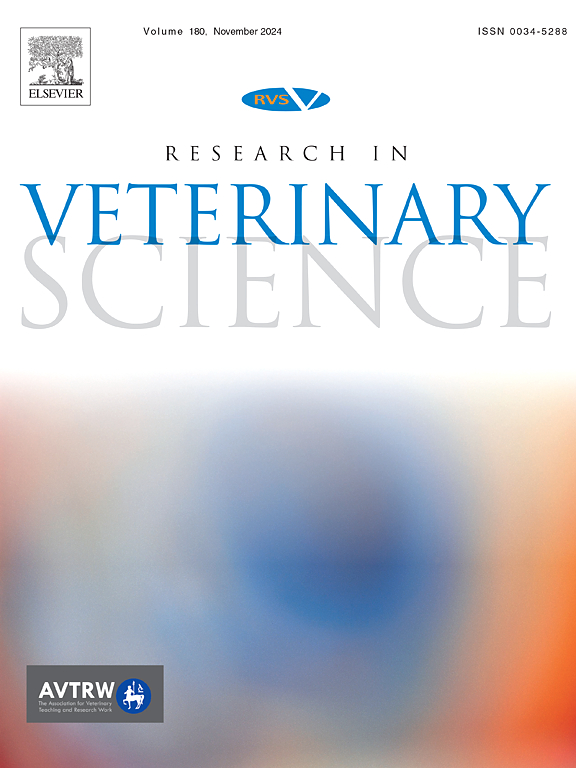LncRNA H19 improves mesenchymal characteristics of buffalo (Bubalus bubalis) bone marrow-derived mesenchymal stem cells under hypoxic conditions
IF 2.2
3区 农林科学
Q1 VETERINARY SCIENCES
引用次数: 0
Abstract
As adult stem cells with various advantages, Bone marrow-derived mesenchymal stem cells (BMSCs) are valuable resources for veterinary treatment and animal reproduction. Previous studies have shown that hypoxia can induce epithelial-mesenchymal transition (EMT) and improve mesenchymal characteristics of BMSCs in vitro culture. However, the mechanism by which hypoxia improves the interstitial characteristics of buffalo BMSCs (bBMSCs) remains unclear. In this study, the effects of hypoxia on the mesenchymal characteristics of bBMSCs and the expression level of lncRNA H19 were examined, and then the effects of lncRNA H19 on maintaining the mesenchymal characteristics of bBMSCs under hypoxic culture conditions (5 % oxygen) as well as its mechanism also were explored, so as to further understand the molecular mechanism of mesenchymal characteristics maintenance of bBMSCs. The results showed that hypoxic culture conditions promoted EMT of bBMSCs, with lncRNA H19 expression up-regulated. When lncRNA H19 was knocked down in hypoxia, the expression level of Vimentin was down-regulated, the expression level of E-Cadherin was up-regulated, and EMT was inhibited. Meanwhile, the genes (p-PI3K and p-AKT1) involved in PI3K/AKT signaling pathway were inhibited by lncRNA H19 Knockdown. IGF-1 (10 ng/mL), an activator of PI3K/AKT signaling pathway, was added to rescued the inhibition of PI3K/AKT signaling pathway caused by lncRNA H19 Knockdown, with the effects of lncRNA H19 on EMT related genes also partially reversed. These findings not only provide theoretical guidance to elucidate the detailed regulation mechanism of hypoxia on mesenchymal nature maintenance of bBMSCs, but also provide positive support to further establish the stable in vitro culture system of bBMSCs.
LncRNA H19可改善缺氧条件下水牛骨髓间充质干细胞的间充质特性
骨髓间充质干细胞(Bone marrow mesenchymal stem cells, BMSCs)作为具有多种优势的成体干细胞,是兽医治疗和动物繁殖的宝贵资源。已有研究表明,缺氧可诱导体外培养的骨髓间充质转化(epithelial-mesenchymal transition, EMT),改善骨髓间充质特性。然而,缺氧改善水牛骨髓间质干细胞(bBMSCs)间质特性的机制尚不清楚。本研究通过检测缺氧对bBMSCs间充质特性的影响及lncRNA H19的表达水平,进而探讨lncRNA H19在缺氧培养条件下(5%氧)维持bBMSCs间充质特性的作用及其机制,进一步了解bBMSCs间充质特性维持的分子机制。结果表明,缺氧培养条件促进bBMSCs的EMT, lncRNA H19表达上调。当lncRNA H19在缺氧条件下被敲低时,Vimentin表达水平下调,E-Cadherin表达水平上调,EMT受到抑制。同时,参与PI3K/AKT信号通路的基因(p-PI3K和p-AKT1)被lncRNA H19 Knockdown抑制。加入PI3K/AKT信号通路激活剂IGF-1 (10 ng/mL),挽救lncRNA H19敲低引起的PI3K/AKT信号通路抑制,同时部分逆转lncRNA H19对EMT相关基因的影响。这些发现不仅为阐明缺氧对bBMSCs间质性质维持的详细调控机制提供了理论指导,也为进一步建立稳定的bBMSCs体外培养体系提供了积极支持。
本文章由计算机程序翻译,如有差异,请以英文原文为准。
求助全文
约1分钟内获得全文
求助全文
来源期刊

Research in veterinary science
农林科学-兽医学
CiteScore
4.40
自引率
4.20%
发文量
312
审稿时长
75 days
期刊介绍:
Research in Veterinary Science is an International multi-disciplinary journal publishing original articles, reviews and short communications of a high scientific and ethical standard in all aspects of veterinary and biomedical research.
The primary aim of the journal is to inform veterinary and biomedical scientists of significant advances in veterinary and related research through prompt publication and dissemination. Secondly, the journal aims to provide a general multi-disciplinary forum for discussion and debate of news and issues concerning veterinary science. Thirdly, to promote the dissemination of knowledge to a broader range of professions, globally.
High quality papers on all species of animals are considered, particularly those considered to be of high scientific importance and originality, and with interdisciplinary interest. The journal encourages papers providing results that have clear implications for understanding disease pathogenesis and for the development of control measures or treatments, as well as those dealing with a comparative biomedical approach, which represents a substantial improvement to animal and human health.
Studies without a robust scientific hypothesis or that are preliminary, or of weak originality, as well as negative results, are not appropriate for the journal. Furthermore, observational approaches, case studies or field reports lacking an advancement in general knowledge do not fall within the scope of the journal.
文献相关原料
公司名称
产品信息
索莱宝
BCA
 求助内容:
求助内容: 应助结果提醒方式:
应助结果提醒方式:


